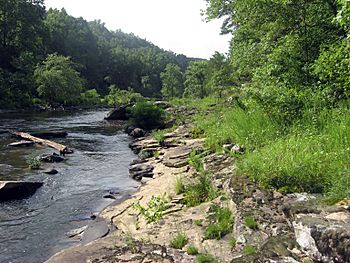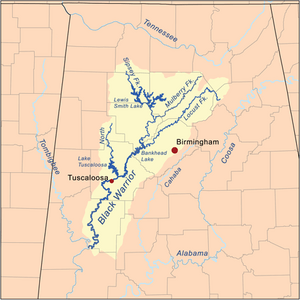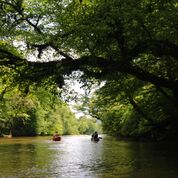Locust Fork of the Black Warrior River facts for kids
Quick facts for kids Locust Fork of the Black Warrior River |
|
|---|---|

The sandstone shelf riverscour has rare plant species
|
|
 |
|
| Country | United States |
| State | Alabama |
| County | Blount |
| Physical characteristics | |
| Length | 158 mi (254 km) |
| Basin features | |
| Basin size | 1,209 sq mi (3,130 km2) |
The Locust Fork River is a cool river in Alabama, USA. It's one of the three main rivers that flow into the Black Warrior River. This river stretches through Blount, and parts of Etowah, Jefferson, and Marshall counties.
The river is about 158-mile-long (254 km). It collects water from an area of 1,209 square miles (3,130 km2). The Locust Fork is famous for its exciting whitewater rapids, which are perfect for canoeing and kayaking. It also has calm, smooth parts where you can go tubing. If you love fishing, you'll find some of the best spots for sport fishing in Alabama here!
The National Park Service looked at rivers across the country. They found that the Locust Fork River is one of the top 2% of free-flowing rivers. This means it's super special in many ways! You can learn more about it on the National Park Service website.
Every year, the Locust Fork River hosts the official Locust Fork Canoe and Kayak Races. It's a big event for paddlers! You can find out more about the races at alabamacupraces.com.
Contents
Protecting the River
In the late 1980s, there was a plan to build a dam on the river. This dam would have supplied drinking water to the city of Birmingham. When people heard about this, a group called the Friends of the Locust Fork River was formed. This group worked hard to find other ways for the city to get water. They held meetings and suggested better ideas. Because of their efforts, the plans for the dam were stopped. This helped keep the Locust Fork River free-flowing and healthy.
River History and Geology
The Locust Fork is a very old river with an amazing past. It has carved its way through tall ridges of sandstone and chert many times. This shows that the river is actually older than the hills it flows through!
Over thousands of years, as the Appalachian Mountains and other lands slowly rose, the river kept cutting through them. Today, you can see its winding path with sharp turns and steep cliffs. These are called "entrenched meanders." The river and the ridges together have created many different homes for a wide variety of plants and animals.
Even with some challenges, the Locust Fork remains a free-flowing river. This helps protect its rich variety of life. However, human activities have caused some rare and unusual species to disappear.
Early Life Along the River
Long ago, Native Americans lived along the Locust Fork River. The river provided them with plenty of food and shelter. Because of this, many old tools and items from their time have been found in the river's watershed.
When early settlers came to the area, the river's winding path meant they had to build many bridges. Some of these old bridges are still standing today!
Today, in Blount County, there are 115 bridges that are longer than 20 feet crossing the Locust Fork River. Settlers also built mills powered by water in almost every valley to grind grain. Most of these old mills are gone now.
Gallery
-
Hymenocallis coronaria is a beautiful flower sometimes seen on the Locust Fork.
Images for kids







